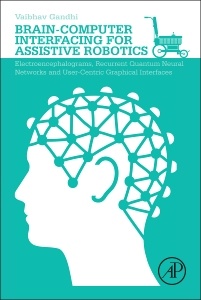Brain-Computer Interfacing for Assistive Robotics Electroencephalograms, Recurrent Quantum Neural Networks, and User-Centric Graphical Interfaces
Auteur : Gandhi Vaibhav

Brain-computer interface (BCI) technology provides a means of communication that allows individuals with severely impaired movement to communicate with assistive devices using the electroencephalogram (EEG) or other brain signals. The practicality of a BCI has been possible due to advances in multi-disciplinary areas of research related to cognitive neuroscience, brain-imaging techniques and human-computer interfaces. However, two major challenges remain in making BCI for assistive robotics practical for day-to-day use: the inherent lower bandwidth of BCI, and how to best handle the unknown embedded noise within the raw EEG.
Brain-Computer Interfacing for Assistive Robotics is a result of research focusing on these important aspects of BCI for real-time assistive robotic application. It details the fundamental issues related to non-stationary EEG signal processing (filtering) and the need of an alternative approach for the same. Additionally, the book also discusses techniques for overcoming lower bandwidth of BCIs by designing novel use-centric graphical user interfaces. A detailed investigation into both these approaches is discussed.
Part 1: Introduction Part 2: Interfacing Brain and MachinePart 3: Fundamentals of Recurrent Quantum Neural Network Part 4: The Proposed GUIPart 5: RQNN Based EEG EnhancementPart 6: GUI and Robot Operation Part 7: Conclusion
He joined the department of Design Engineering & Mathematics, School of Science & Technology, Middlesex University London in 2013, where he is currently Lecturer in Robotics, Embedded Systems and Real-time Systems.
His research interests include brain-computer interfaces, biomedical signal processing, computational intelligence and neuroscience, use-centric graphical user interfaces, and assistive robotics.
- An innovative reference on the brain-computer interface (BCI) and its utility in computational neuroscience and assistive robotics
- Written for mature and early stage researchers, postgraduate and doctoral students, and computational neuroscientists, this book is a novel guide to the fundamentals of quantum mechanics for BCI
- Full-colour text that focuses on brain-computer interfacing for real-time assistive robotic application and details the fundamental issues related with signal processing and the need for alternative approaches
- A detailed introduction as well as an in-depth analysis of challenges and issues in developing practical brain-computer interfaces.
Date de parution : 09-2014
Ouvrage de 258 p.
15x22.8 cm
Thèmes de Brain-Computer Interfacing for Assistive Robotics :
Mots-clés :
Autonomous robot control; BCI competition; BCI quantifiers; Brain-computer interface; Brain-robot interface; Classification; Cross-validation; EEG data acquisition; EEG filtering; EEG signal processing; Electroencephalography; Evaluating BCI; Evoked potential; Eye tracker system; Feature extraction; Graphical user interface; Hybrid BCI; Intelligent adaptive user interface; Motor imagery; Optimization; Post-processing; Quantum mechanics; Quantum neural network; RQNN; Recurrent Quantum Neural Network; Robot operation; Schrodinger wave equation; Signal filtering; Supervised robot control; Synchronous/asynchronous BCI



